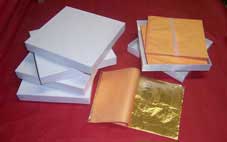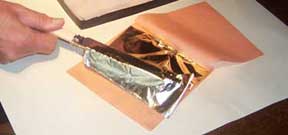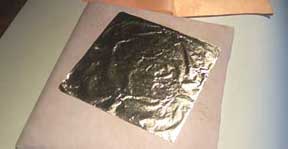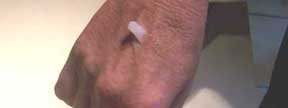Gilding with Dutch Metal Leaf

Dutch Metal
leaf is an alloy made from brass, copper & aluminium it
comes in different shades, the shade I use is a close match for the
colour of genuine 23 carat gold leaf.
This is
a very
underestimated material in my experience. I found many
different uses for this gold leaf substitute over the
years.
Each book
of Dutch Metal contains 25 leaves about 5 inches square,
it handles in the same way as genuine gold leaf but as it is a
little thicker it is more forgiving in use.
When genuine
gold leaf is used outside it has to be protected with a clear
varnish, Dutch Metal is the same, it has to be protected
with a clear lacquer, but this is not a problem as almost all the
glazes and ageing processes shown on this site call for the leaf to
be given a coating of lacquer of some sort.
Handling
Dutch Metal Leaf
You do not
need a lot of equipment to be able to gild successfully, but
handling the leaf can be a problem for the
inexperienced.
To handle
the leaf you will need a minimum of equipment.
A gilding
cushion and a gilding knife, are the only major items, the
other materials, vaseline, cotton wool, pumice powder and the leaf
itself are very cheap.
One hint, if
you can find a straight edged cutlery knife from the 1950's or
before you will have a very good gilding knife.
As handling
the leaf is so important I have provided here a step by step
illustrated method which follows.This subject is also covered in
detail in my manual which is available from the downloads page.

First scoop out about half a teaspoon of
pumice powder with your gilders knife and put it on the cushion. It
is vital that your cushion is free from any traces of grease and
the pumice acts to degrease the cushion
The gilding
knife should not have an extremely sharp edge or it will cut into
the leather of the cushion, rather it should be slightly rough.
Using the gilders knife spread the powder over the surface of the
cushion, use the edge of the knife, not the flat blade, and gently
scrape the powder back and forth so that it covers the entire
cushion. This will remove any traces of grease from the
cushion.
Wipe the blade on
the cushion to remove the powder from the knife, then brush of the
surplus powder from the cushion again with your gilders knife. Take
some care that you remove traces of pumice powder from your knife
by wiping the knife on the cushion.

Open your
book of Dutch Metal and insert the blade under one of the leaves of
gold. Some gilders use a shield around the cushion to prevent
drafts from blowing the leaf around; I prefer to have a space where
no drafts can get in. I suggest strongly that you should put the
cat out when gilding, they can be so curious I have
found.
Gently lift the
leaf of gold over to your gilders cushion and lay the leaf out as
flat as you can, practice will make you perfect at this. If the
leaf does not lie down perfectly flat, you can gently blow down
onto to the surface of the leaf; your breath should flatten out any
irregularities.

I
would say that this is flat enough for you to
work with. What we do
next will depend on what we are gilding; I am preparing to
gild the edge of a picture frame so I need small pieces of
leaf to work with. If you are going to gild a large flat
surface you may decide not to cut the leaf into smaller
pieces, generally I have found that smaller pieces are easier
to handle, but were I about to gild a large flat surface I
might cut the leaf into four to work with or even work with
single sheets.
For this piece of work I am going to gild
the edges of a frame so I am cutting up the leaf into
smaller pieces, this frame is simple for the purposes of
illustration but of course if you are dealing with a complicated
surface smaller pieces will help you anyway. Gently draw your knife
through the leaf exerting a moderate pressure while doing so, if
the edge of your knife is sharpened correctly one cut should be
enough to cut the leaf.
Here you can
see all the separate pieces of leaf cut up and ready to
use.

Next put a dab of Vaseline on the back of your
hand a smear it over your hand in a circular motion to distribute
the grease all over the back of your hand, we do not want blobs of
grease left, rather a thin film should be distributed over
surface.
Get a small pad of cotton wool and press it
lightly onto the back of your hand which has the grease
on.
With the
lightly greased pad of cotton wool you will find that you can now
easily pick up the pieces of gold leaf.
There are other ways to handle gold leaf, but
this is easy and predictable.
If you have greasy skin you may find that
rubbing the cotton wool pad down the side of your nose will pick up
enough grease for you to pick up the pieces of gold leaf. All this
did for me was to give me a sore nose, but I have seen it work with
some people, I just mention it in passing.
Someone said recently that my manual helped to
bring the process to life, up to that point this person only had
text to guide him.
OK, I spent some time illustrating how
to handle the leaf because it is important to be able to handle it
properly. The rest of the process's are simpler by comparrison.
Next let's have a look at the adhesives used in gilding.
click
here.
| 





